Presidents: Franklin Delano Roosevelt
Home of Franklin D. Roosevelt National Historic Site, Hyde Park, New York
Visited in 2009 and 2017.
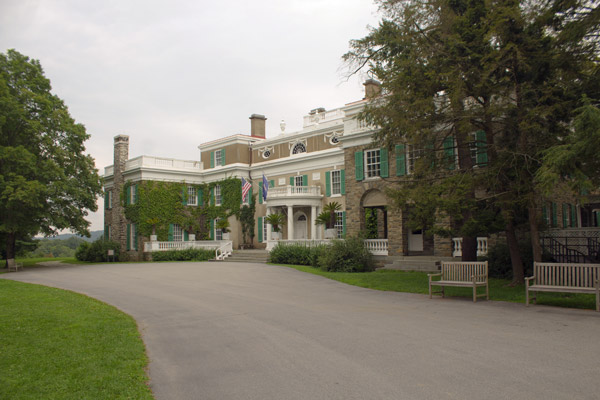
Springwood: FDR's birthplace, boyhood home, adulthood home, and prison.
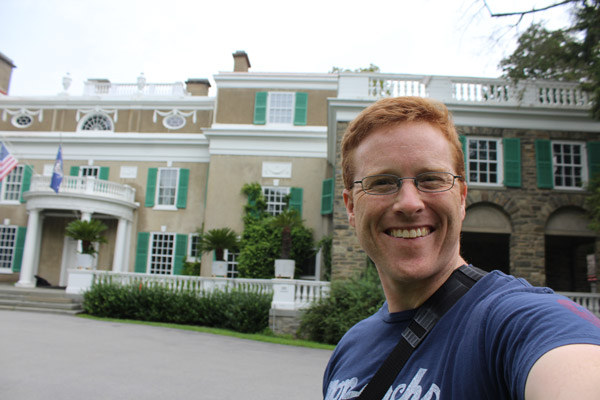
Yes, I wore the "Monarchs" shirt on purpose.
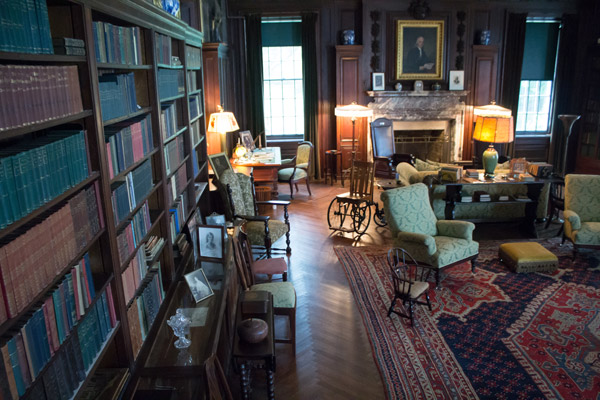
FDR's elegant library, where he entertained many high-rollers. Wheelchair pun intended.

The room where FDR was born. Since it was FDR, I assume it was a full-term pregnancy.
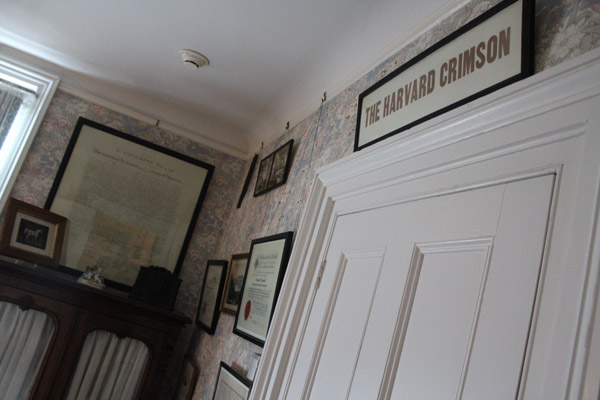
The first rule of Harvard is tell everyone you went to Harvard.
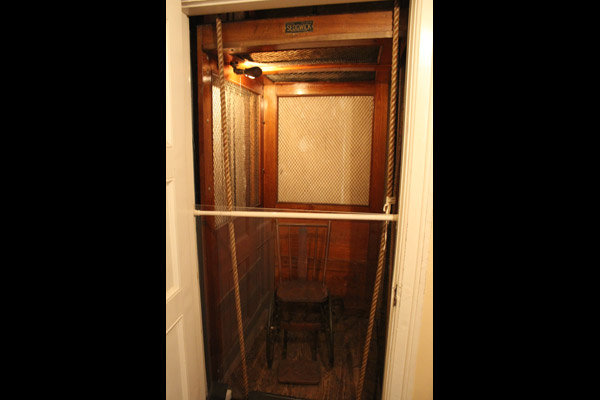
The muscle-powered trunk elevator FDR used to change floors.
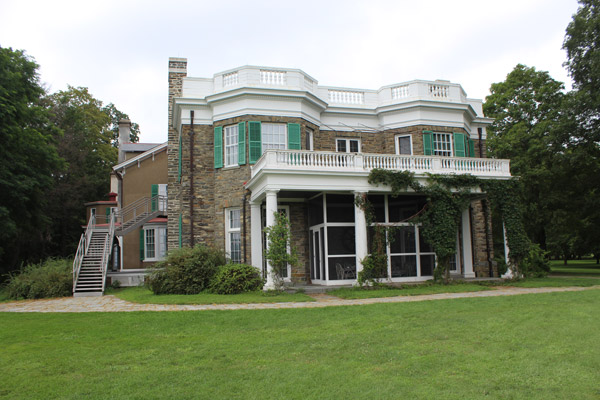
A side view of the mansion.
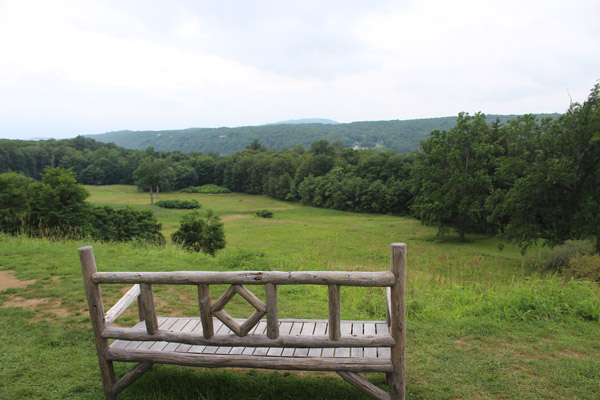
Looking out toward the Hudson River. The Roosevelts had a very nice spread.
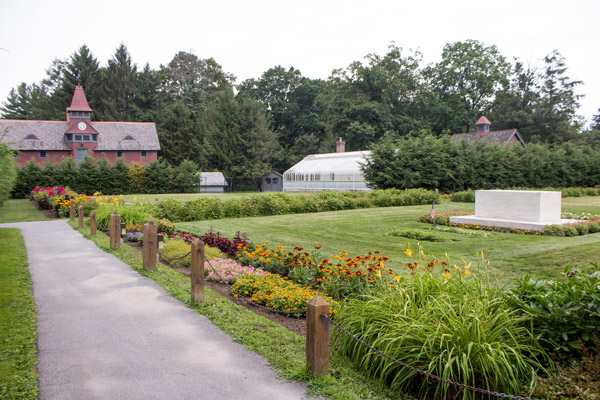
FDR's grave, in the garden right next to the mansion. He drew up the specs for the marker.
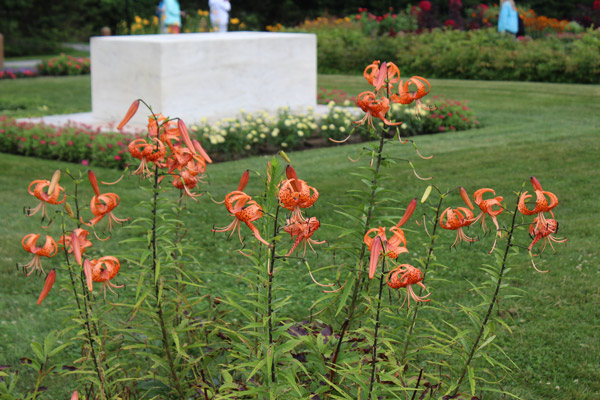
FDR wanted a grave marker no larger than his desk, for some reason.
Touring the Springwood estate, the thought occurs that Franklin Roosevelt might have had slightly more success ending the Great Depression by just giving everyone in America $10,000.
He clearly had the money. The guy was rich! The kind of rich where you have not just a mansion, but a vacation compound in Canada and a spa in Georgia. And since things are so hectic at your mansion, you decide to build another house on your property, THREE MILES away. And a house for your wife, who was probably a lesbian. Yes, he was Estranged-Lesbian-Wife rich.
The money came from the best source known to man: inheritance. The Hudson Valley Roosevelts had oil money, railroad money and banking money, not to mention a big honkin' farm. And the seafaring Hudson Valley Delanos, who did a lot of business in China, had rice money and opium money. In a worst-case scenario, FDR was going to be a high-functioning society alcoholic. As it turns out, he had some ambition, so he became the most prolific president in American history. And so a visit to Hyde Park really drives home the central contradiction of the FDR years: our leader at the time of our greatest hardship was a guy who never had to worry about finance a single day of his life. FDR rewrote the compact between government and citizen even though he couldn't have been further removed from the people he was trying to help.
It's really something. The mansion itself is phenomenal, if not overly extravagant. (It's a mere 20,000 square feet, compared with the 50,000 square-foot Vanderbilt home, just a little farther up the Hudson river.) As nice as it is, you can still tell that it's a farmhouse. FDR expanded the home to fit his family, but there's nothing "gilded" about the home. It has a few of the flourishes designed especially to impress guests -- you get those same touches in the 18th century Virginia plantations -- but it's not lacking in coziness or personality. The walls of the foyer are covered with nautical prints (entirely FDR's fetish, like in his home at Warm Springs), a cabinet of stuffed birds (taxidermy was a hobby FDR shared with TR) and political cartoons. FDR was proud of his collection of the last item; even though many of the cartoons were anti-British screeds from the war of 1812, he declined to cover them up when entertaining the King of England. Supposedly, after a few minutes of awkward study, the king noted that FDR had a few in his collection that the king himself was missing.
There's a great story to almost every room. The library is where FDR would greet guests, and maintain the charade of his health. (It was common knowledge that he had polio, but not that his legs were basically useless.) He would have guests escorted in to find him seated and cross-legged in the library; before anyone could wonder why he hadn't stood up to greet them, he would charm them into submission. Upstairs, there's the room where he slept as a child, complete with memorabilia from his youth, like the placard from the Harvard Crimson. (College newspaper editors are always destined for greatness.) You can see the room where he was born, and the room where Winston Churchill once took a bubble bath. There's an elevator which was so necessary for a crippled man, but oddly enough powered like a dumbwaiter. The man famous for fireside chats had an overwhelming fear of fire, because as a child he had seen one of his aunts engulfed in flames after a lamp accident, and as a man of limited mobility he feared having live electricity in his own home. He used his own muscle power to operate the elevator, which explains why most of his 190 pounds was upper-body muscle. Outside is the long carriageway that he tried to walk every day he was at Springwood; he never made it to the end, but he always tried.
Plus there's the whole family dynamic on display. FDR was a momma's boy, since he was essentially an only child. His mom was half his dad's age, and so Roosevelt's only sibling (a half-brother) was 28 years his senior. His mom doted on him and was technically the owner of his house well into his adulthood; she was basically the mother figure to his kids, since she steamrolled Eleanor at every opportunity.
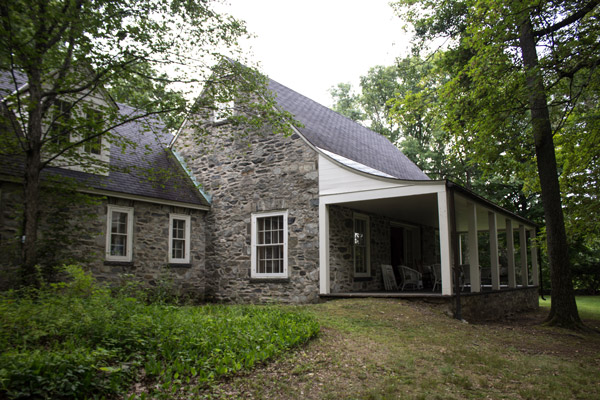
Top Cottage: The handi-capable retreat designed by FDR himself.
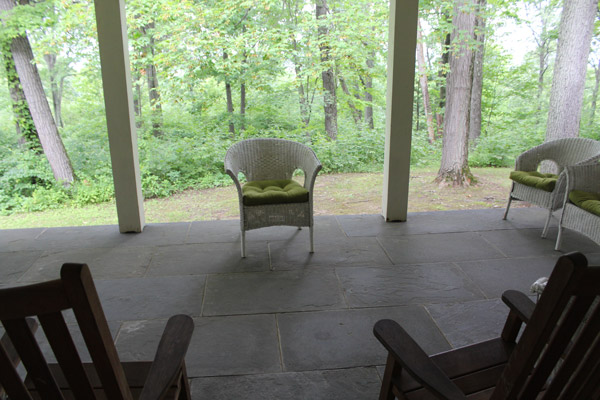
The porch at Top Cottage, where "The King's Speech" guy ate hot dogs.
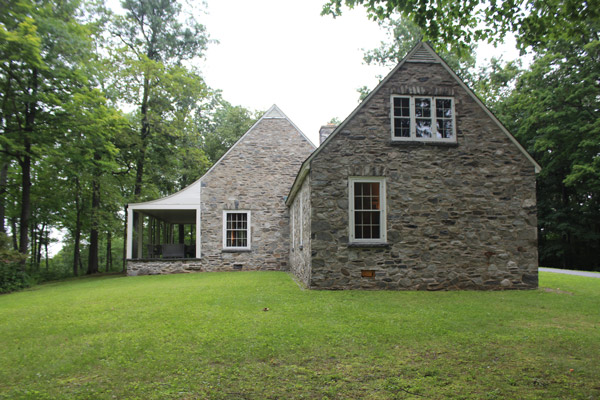
Top Cottage: A side view of FDR's home away from home away from home.
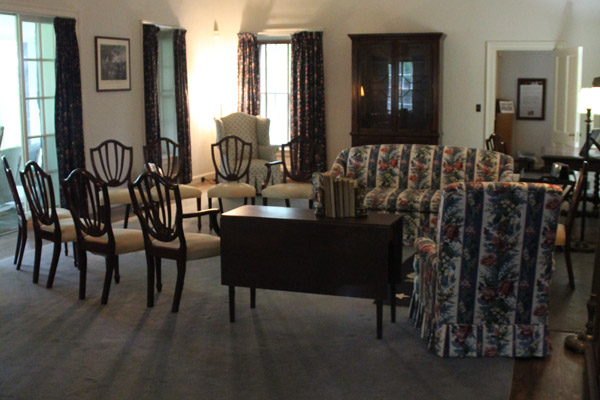
Top Cottage: Note the low window sills, for wheelchair-bound FDR.
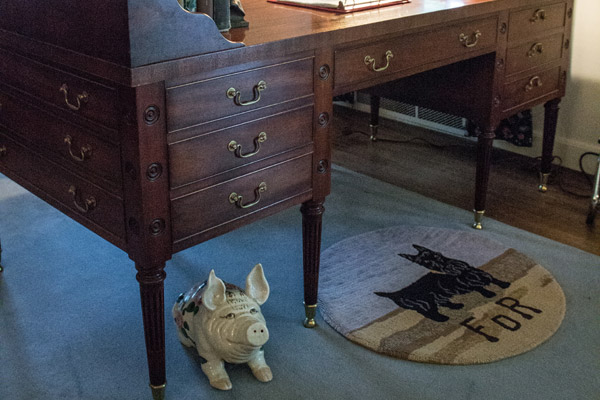
Top Cottage: The decor of a very wealthy man.
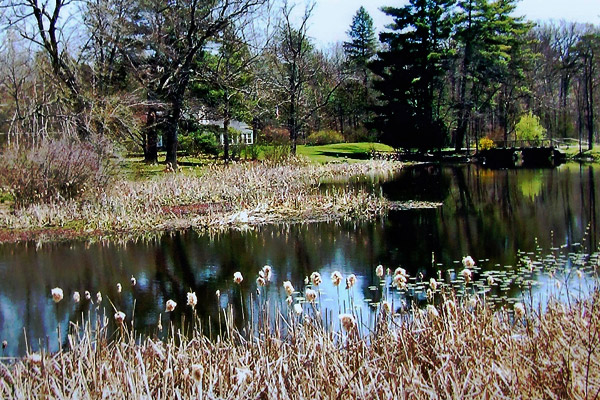
Val-Kill: The pond at Eleanor Roosevelt's home.
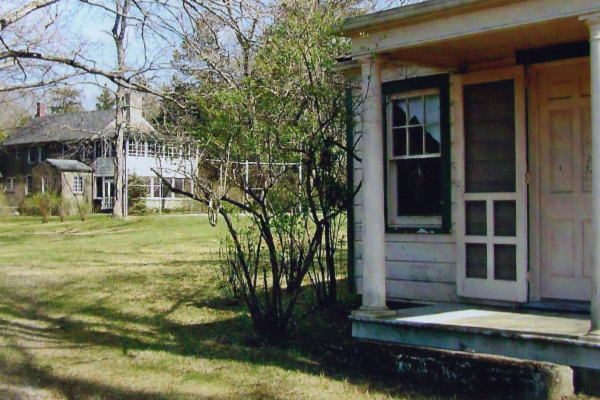
Val-Kill: Some of the structures where Eleanor and friends lived and worked.
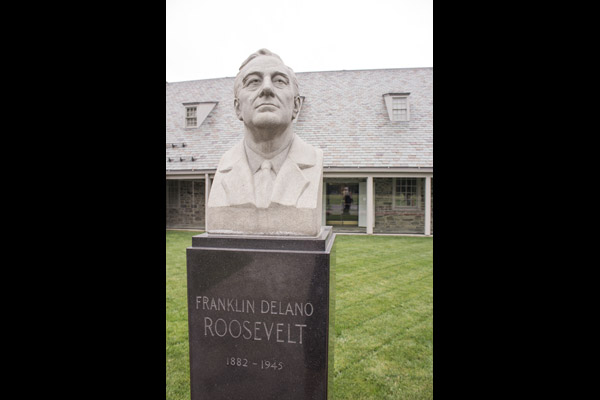
Outside the first presidential library.
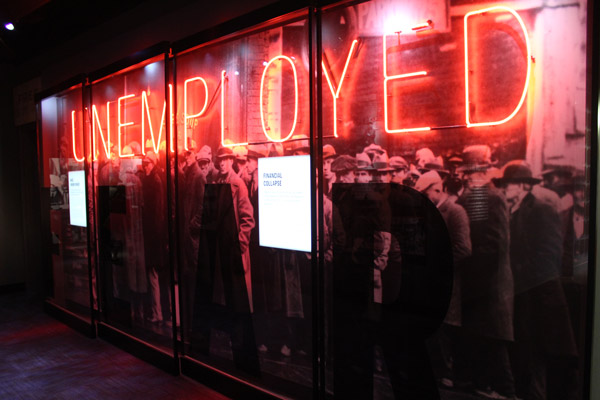
The Great Depression section of the FDR museum.
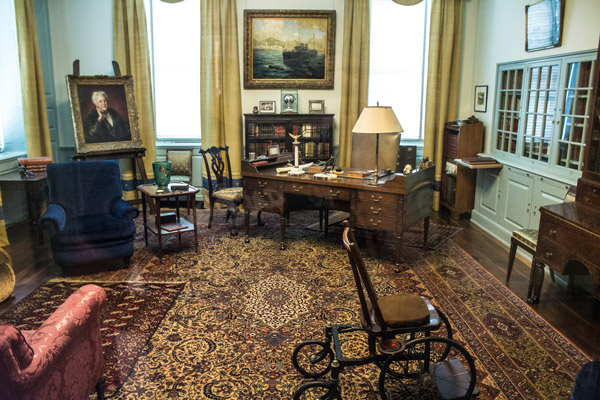
Museum: FDR's actual Hyde Park office, kept in excellent condition.
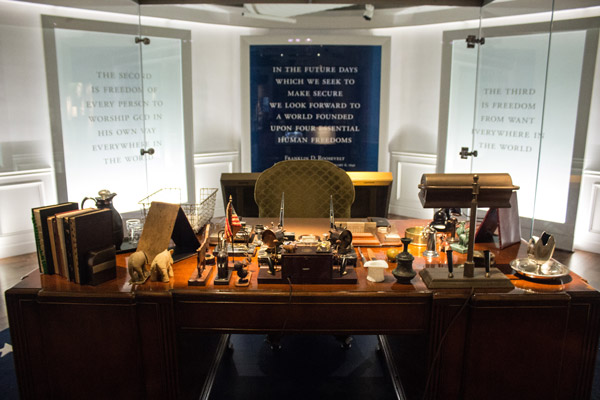
Museum: A re-creation of FDR's desk, complete with knick-knacks.
What makes Hyde Park an especially great place to visit -- I consider it a top three presidential site -- is its depth. There's so much more to see than FDR's ancestral home. For example, there's Eleanor. You can't really understand FDR without looking at her. In a lot of ways, she seems to be the link that tied FDR to the American people. Unable to travel the country with abandon, he left that task to her, and it was her reports of the American condition that so often influenced his positions on social issues or the economy. She was a First Lady of almost unprecedented importance, in terms of her national profile, her political influence and her ambition -- which was kindled by FDR's own aides. FDR and Eleanor were estranged -- that tends to happen when you bang your wife's secretary -- but they were weirdly respectful and affectionate toward each other, probably because it was the early 20th century and divorce would have made them political pariahs.
To preserve the status quo, FDR built Eleanor a cottage on his family's estate. It was a place where she could relax and get away from the pressures of entertaining in the big mansion. That cottage, called Val-Kill, is just a 3-mile hike from Springwood, and it's the only national historic site devoted to a single First Lady. It's a home where her personality outshines FDR's. She lived there until her death in 1962.
And just a mile past Val-Kill is Top Cottage, FDR's personal retreat. It's a small building planned by FDR himself to be handicapped-accessible, a home where the "grand deception" of Springwood could be put to rest. FDR wasn't a trained architect, but he had enough input to be considered the cottage's designer. It had lower windows, level threshholds on the doors, and open floor plan and a dirt ramp sloping up to the porch. The overall style is "Dutch colonial," which is a spartan, cheap and effective way to make a building.
He wanted to retire there, as his plan was always to leave Springwood to the government. There's also some quasi-adulterous romantic elements, as Roosevelt liked to frequent the house with Margaret "Daisy" Suckley, his fourth cousin and possible mistress. Whatever the nature of their relationship, it got a lot closer after he was stricken with polio. If they were boinking, it's even creepier than FDR's marriage. At least Eleanor was a fifth cousin.
Daisy and Franklin picked the location together, calling it "our hill" and "our house," but they didn't get their happy ending. FDR spent only 130 or so days there, and perhaps no nights -- his mom (Sara) was pissed about no one coming back to Springwood to rub her corns. But it might have witnessed some history. My guide intimated that the Lend / Lease Program and the Manhattan Project had origins in conversations that took place at Top Cottage. And it definitely was the setting for one giddily historic occasion. When the king and queen of England visited, FDR personally drove them to Top Cottage, then treated them to their first ever hot dogs on the porch. The king got mustard on his suit. History does not often record where world leaders had their first hot dogs, and so I consider Top Cottage to be a sacred place. It's a short tour but a fascinating bit of history.
Finally, there's the presidential library. Among his many accomplishments, FDR essentially created the concept of the presidential library. He knew he was a big deal. He knew historians would want to study everything about him. And so in 1939 -- while he was still president! -- Roosevelt donated his personal and presidential papers to the government. Since he had the money, he even built a place to put them. FDR created a research facility just a short walk (or roll) from Springwood. He kept his office there, and they keep it more or less the way FDR left it. In the decades since, NARA has added a museum. It wasn't that great when I visited in 2009, but by the time of my return visit in 2017 they had greatly improved it. The coolest relic, for my money, was the bullet from an assassination attempt. The slickest exhibit was FDR's desk, with an interactive video display giving the history of the many, many tchotchkes on display. The man liked his pig figurines.
There's a lot to ponder about FDR. He had such a profound impact on the shape of modern American society, our relationship with government and international affairs that it's hard to avoid him. He was opportunistic, but compassionate; he had a silver-spoon upbringing, but he suffered enough through his illness that you have to respect his hard work and dedication. As much as he could manipulate and use people, he still trusted and respected Eleanor enough to follow her guidance. He was both a genius and a bully. If you have a day to spend in Hyde Park you can pull together strands from so many phases of his life. It won't give you the answers, but it'll give you something to think about.
Plus there's always the final resting place ... in his mom's rose garden, right next to the house, along with Eleanor and Fala. The marker wasn't supposed to be any bigger than his desk, and considering that the guy already had his own library AND was giving his ancestral home to the government, the whole scene is surprisingly subdued. I guess when the entire country is your memorial, you don't need that much of a marker.
Special thanks to super-guide Valerie (I think it was Valerie; it definitely had a V at the start). She was my tour guide for both Springwood and Val-Kill in 2009, and since I wasn't in any kind of rush, I bombarded her with a LOT of questions. She didn't flinch once, because PARK RANGERS KNOW THEIR STUFF. Always pester them. I think they like flexing their muscle. I even got her personal assessment of whether Franklin was a nice guy. For the record, she thought he was genuine in his desire to help people, but his blue-blooded willingness to use anyone for any purpose at any time probably put a few people off. That sounds about right.
Roosevelt Campobello International Park, New Brunswick, Canada
Visited in 2019.
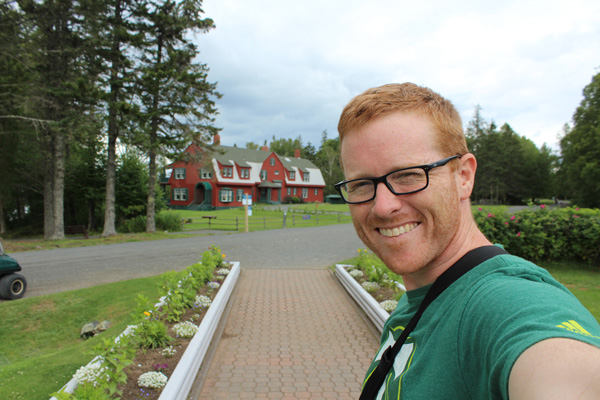
Come on in! The water is ... uh, distressingly cold for summer!
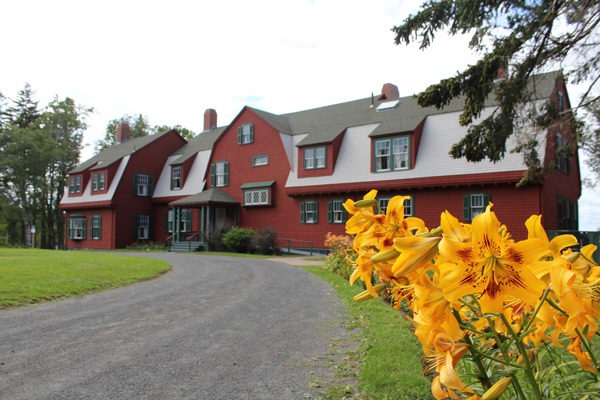
Your typcial cozy little vacation home, FDR style.
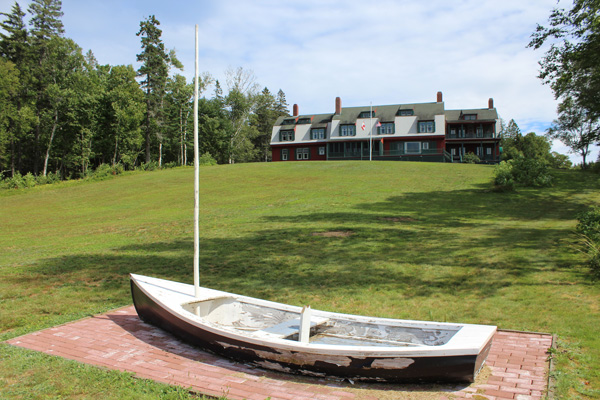
Looking up at the cottage from the large lawn leading to the shore.
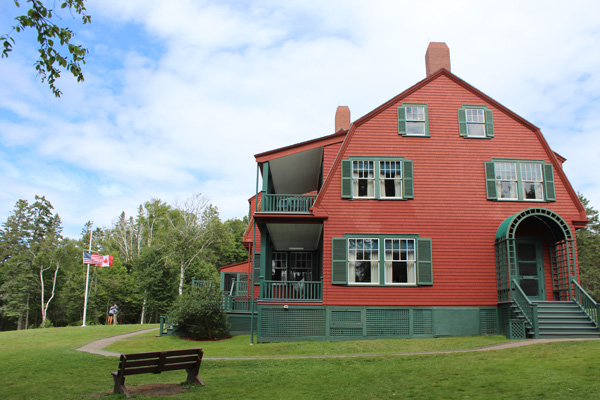
A side view of what was politely called a cottage.
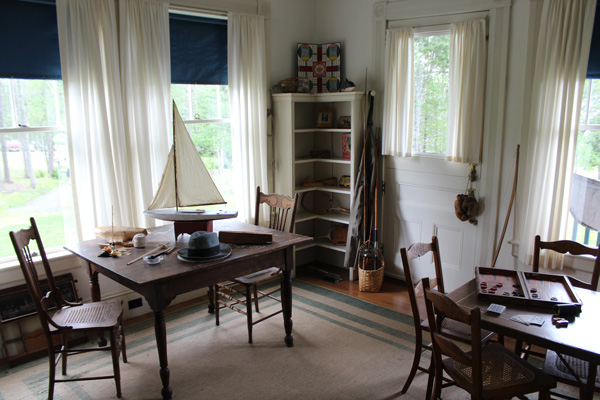
The sun porch / mud room / handicapped accessible room.
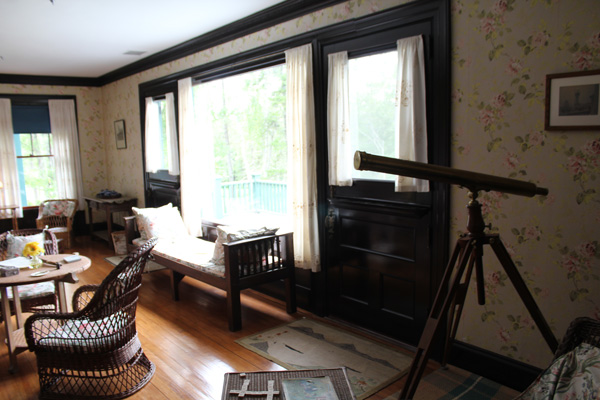
The family room / living room. I belive the telescope was FDR's.
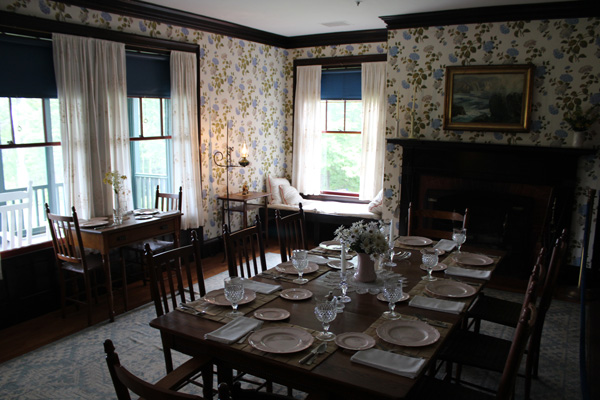
There are no vacations from fine dining. Although they did eat a lot of hot dogs.
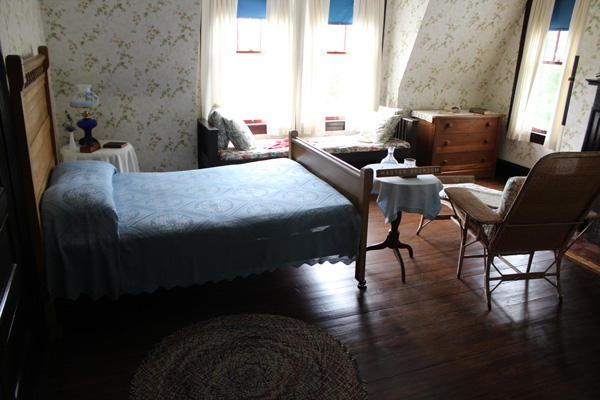
One of the fairly modest bedrooms. The cottage is big, not fancy.
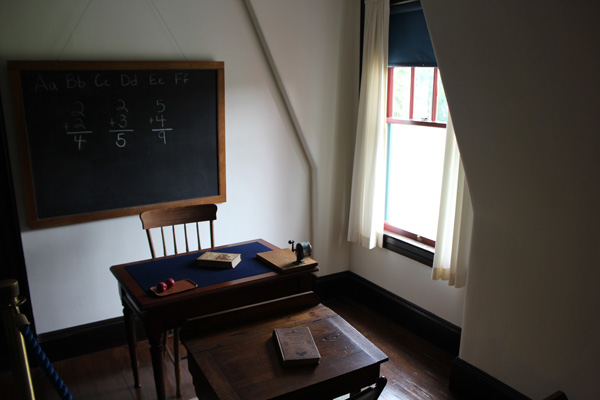
The kids' classroom, because learning is a vacation for your MIND.
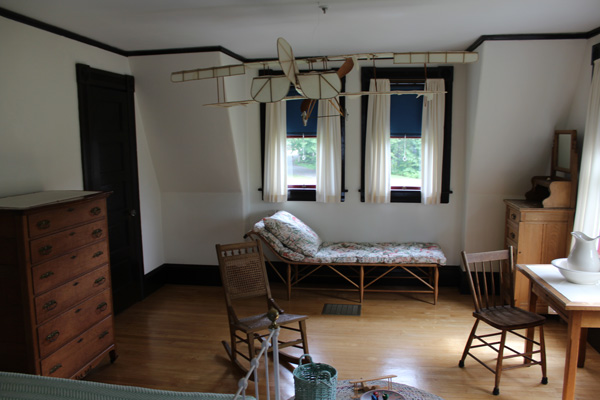
The boys' bedroom, complete with kick ass glider.
Three simple truths should guide our lives. Be kind to one another. Honesty is the best policy. And there's no point in amassing a multi-million dollar family fortune in the opium trade unless you're willing to spend it. The Roosevelts weren't always kind or honest, but they definitely nailed the third thing. The family fortune paid for great educations, political campaigns and -- most important -- astonishing leisure.
One of the great leisure activities of the late 19th century was "summering." When rich people didn't like the hot weather at their usual estates, they went somewhere cooler, lived there during the summers, then had creepy old caretakers watch the property during the brutal winters. Gazillionaires from Pittsburgh headed to the mountains above Johnstown, Pa., where everything worked out great and nothing notable ever happened. Some high-rollers from the East Coast headed for the mountains of North Carolina. Industrial giants of the northeast set up camp in Newport, Rhode Island.
Unfortunately, in the Gilded Age there was a glut of rich people, so in some resort areas money couldn't buy both property AND exclusivity. If you wanted elbow room for your family and two dozen manservants, you had to venture a little farther. In the early 1880s, a group of businessmen from Boston and New York purchased a big chunk of Campobello Island in the Bay of Fundy and developed it at a resort. There was great sailing (perfect for showing off your yacht!), rocky beaches for modest Victorian sunbathing, and plenty of fresh Canadian air.
At first, the wealthy stayed in very nice hotels. Then, the families that really loved the place bought their own lots and put up "cottages." In many cases these were very large buildings, but if your primary residence was 20,000 square feet, they probably felt cozy.
Sara and James Roosevelt loved Campobello Island, so they went all in and bought a cottage. James keeled over around the turn of the century, but Sara and her son kept taking the trip north. In 1909, the woman who owned the next-door cottage died. Sara snapped up that property and gave it as a wedding gift to Franklin and his relatively new bride, Eleanor. All they expected was the 3-quart non-stick saucepan on their registry, so you can imagine what a pleasant surprise it was to get a chunk of an island in Canada.
The upshot of this story: Campobello Island is now home to one of the most remote and unusual presidential sites, and in 2019 I finally got to visit. It's actually not that hard to find. All you have to do is fly to Boston, rent a car, then drive 360 miles north along the water. If you reach Prince Edward Island you've gone too far. And don't forget your passport! Roosevelt Campobello International Park is jointly administered by the U.S. and Canada, although I got the impression that Canadians were doing most of the heavy lifting. You can drive to the island, via the bridge that connects it to the easternmost city in the United States: Lubec, Maine. Just a few minutes past the border checkpoint you'll find the entrance.
Frankly (hah!), it's awesome. I'm not the biggest FDR fan, but his estate at Hyde Park offers a dynamic display of his personality, making it one of my all-time-favorite presidential sites. Campobello is right along those lines. The centerpiece of the park is FDR's cottage, which was in regular summer use from the time of its acquisition until the early 1920s. It fell out of favor because active, outdoorsy vacations are a lot less fun when you have polio. In fact, FDR was "stricken" while at Campobello in 1921. The popular theory is that he contracted the disease at a Boy Scout event in New York a few weeks before. Then, while on vacation, he suddenly fell off his boat and into the Bay of Fundy. Within a few days his legs weren't working, and a month later he was medevaced to New York. Then, the left-wing media collaborated in a massive cover-up for the next 24 years, to advance a Marxist agenda. But you already knew that.
The cottage is maintained in its fully furnished pre-polio 1920 glory, with a bunch of original furniture and complementary period-appropriate stuff to fill in the blanks. And it's cool! While the Roosevelts were gob-smackingly rich, their decorating style for their vacation home wasn't particularly opulent. Supposedly this was Eleanor's doing, since at the point it was the first home where she had the final say -- Sara called the shots at Hyde Park. The cottage didn't have electricity, and in true beach house style most of the 30+ rooms are bedrooms and bathrooms. You probably see the most personality in the boys' bedroom, the makeshift classroom (because what's summer vacation without live-in tutors?) and the sun porch area. The porch, they said, is where FDR spent most of his time after the polio hit, since the cottage wasn't handicapped accessible.
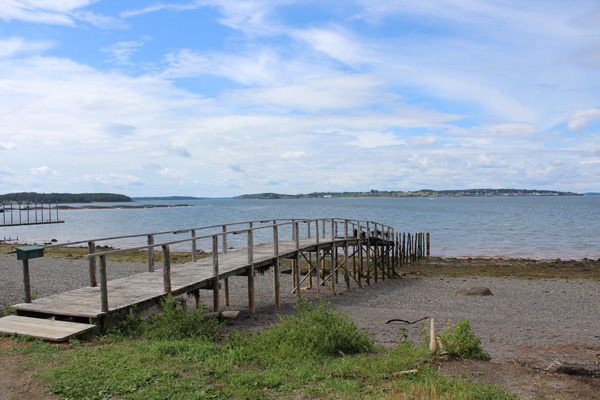
The bay in front of the cottage. You can see from the dock that the tide shifts a LOT.

30 seconds before my polar bear plunge. Or not.
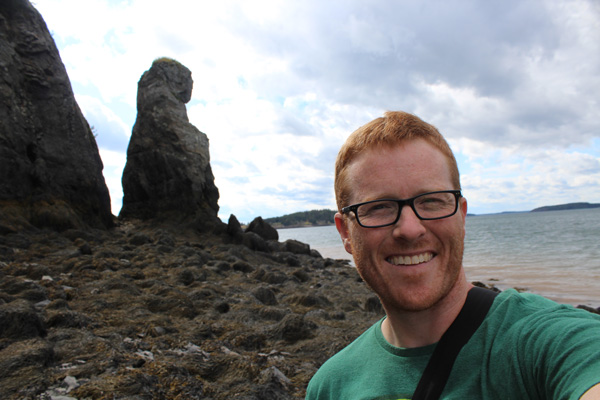
A walk on some slimy rocks got me to Friar's Head.
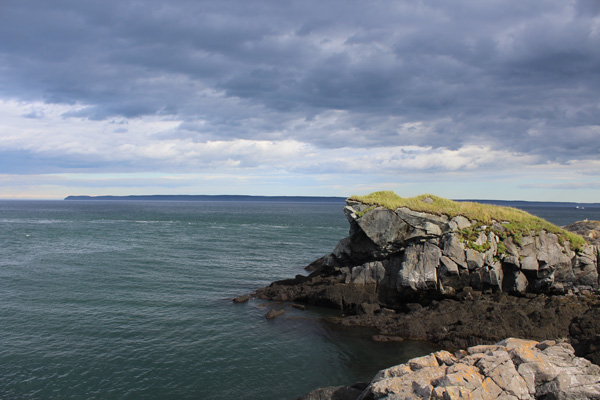
One of the island's scenic overlooks. FDR supposedly searched for pirate treasure on the distant island.
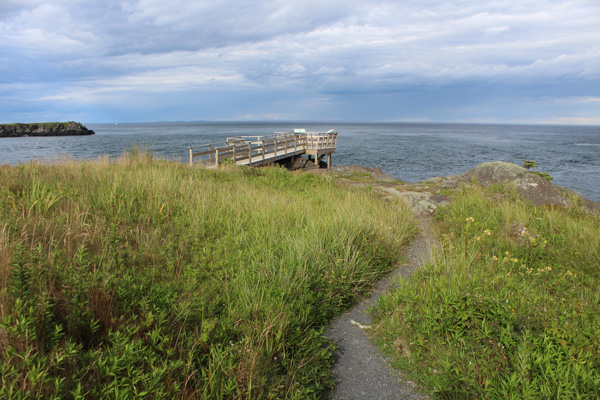
Another scenic view across the water. Fun!
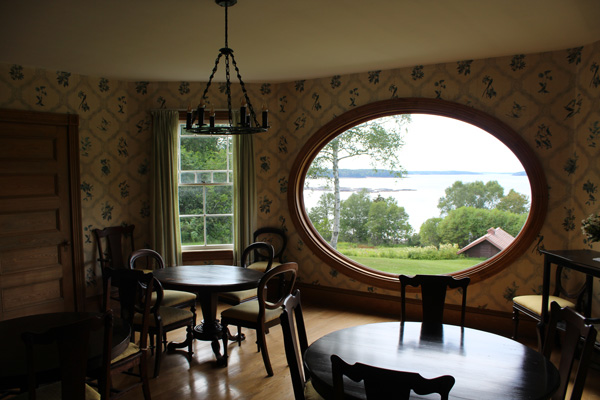
A quick peek at the cottage next door, owned by a concert pianist and friend of the Roosevelts.
Actually, most of the really fun stuff at Campobello would have been spoiled by permanently withered legs. What makes the park special is the very large swath of nature that is preserved for visitors to experience, in the way that Roosevelt and his contemporaries did. You can walk on the rocky beach in front of FDR's house, and around the point to the "Friar's Head" rock formation jutting out from the cliffs. The old carriage roads covering the south part of the island are maintained (and in some cases improved) for drivers, so you can cruise in, park your car and see first-hand what a Canadian bog is like. (They're like American bogs but more polite.) You can also enjoy all the shoreline walks and vistas where vacationers would have spent their daylight hours. I went in mid-August, and it was already a little cool, but the island does have rugged beauty in spades. You could easily kill a few hours taking it all in.
Or, if you're strictly an indoor person, you do have a few other things to see. The park owns and operates a few other existing cottages, including the ones on either side of FDR's. One is operated as a pretty damn good lunch spot; the other is sometimes open for tours so you can see another example of how the 1 percent lived in the 1920s. They share a bunch of info on the "colony" community and how the visitors integrated with the locals over the years.
No historic site is truly "immersive," but the Campobello International Park gives it a pretty good go. The next time you're at the end of the world, it's worth a visit.
Roosevelt's Little White House State Historic Site, Warm Springs, Georgia
Visited in 2007.
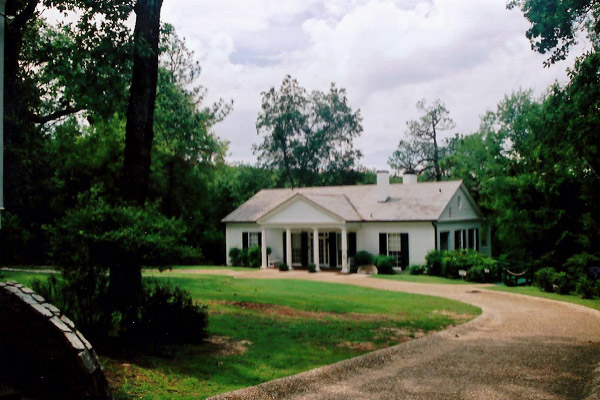
The Little White House. Apologies for the 2007 photo quality.
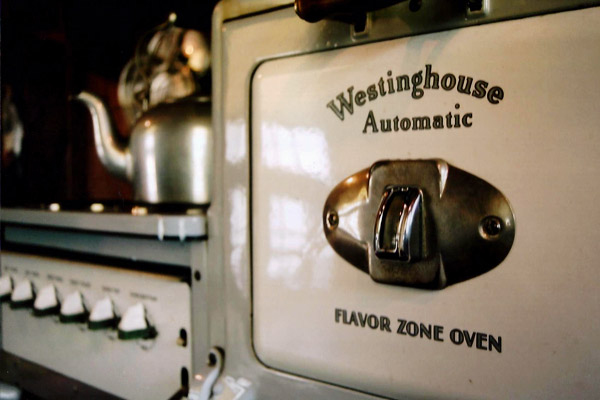
The finest stove that FDR's money could buy.
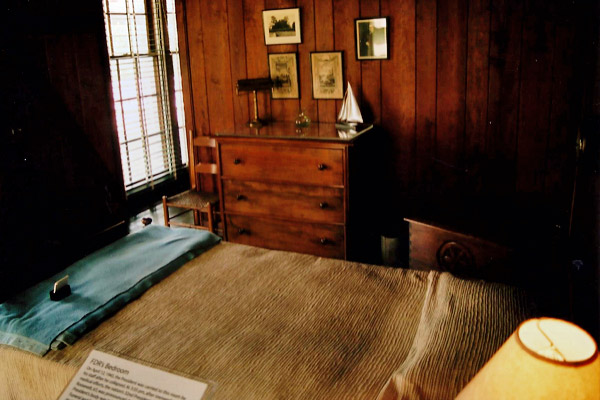
The very bed where God imposed term limits in April 1945.
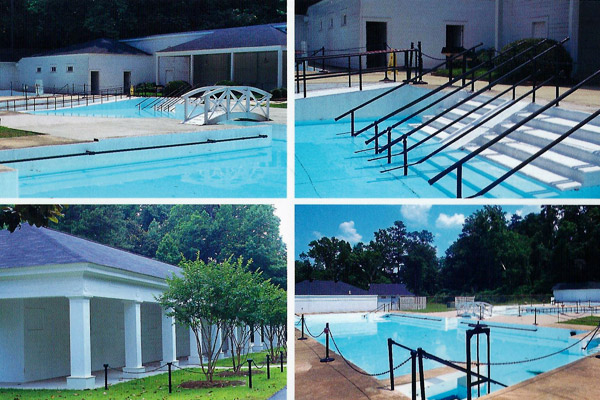
Scanned-in postcards from the hydrotherapy institute.
I leave it to historians to decide if Franklin Delano Roosevelt pulled our nation up from Depression or saddled it with crippling economic programs; whether he steadied our national character or infected the American spirit with a creeping sense of entitlement; whether he led us bravely to victory or left our forces idle for too long as the world plummeted into disaster.
I know only this: I would have hired him as an interior decorator.
The Little White House in Warm Springs, Georgia (about 90 minutes from Atlanta), was a real kick. It was Roosevelt's home away from home away from home -- the place he spent his time when he wasn't in Hyde Park or Washington, because he liked to cool his largely paralyzed heels in the warm soothing waters of the Georgia mountains. It's a neat way to see the softer side of Roosevelt, the guy who spent hours on end playing with polio-crippled kids in a swimming pool on his vacations away from ... uh ... putting people in camps.
Hey, it was a complicated time.
The house is tiny, and not what you'd expect from a guy with so much money that he used a cigarette holder and wore a top hat. It's almost like a mini beach house, only stuck in the mountains. If I had FDR-type money, I would buy it totally furnished without touching a thing. Roosevelt was a navy fanatic (former assistant secretary, just like his cousin Teddy) and everything in the central living/dining room area is BOAT-TASTIC! Model ships, paintings of burning boats and John Paul Jones, a print of Lord Nelson ... Plus, by Roosevelt's instructions, everything is made of dark wood and rough around the edges to create a "captain's quarter's" feel. Neat stuff. Roosevelt was sitting in that room having his portrait painted on April 12, 1945, when he experienced some technical difficulties with his brain. Three hours later, in the adjacent bedroom, he was dead.
Today the house is basically unchanged from the day he died. The books on the shelves are Roosevelt's, the furniture is all original, and you can even see one of the leashes for Fala, FDR's terrier, hanging in the linen closet. They moved FDR's body from the bedroom, so you aren't getting the full experience, but it's still neat to see the spot where he passed away.
And right down the road are the warm springs themselves. FDR bought the bathing complex in the 1920s. He then renovated the whole thing for the use of the hydrotherapy institute he founded, to help treat paralysis and whatnot. When I visited in 2007 the pools were drained, but you could actually walk down in the bottom and feel some of the water coming out of one remaining fountain. The water tempertature was in the 80s, and FYI, they don't like it when you try to wash your socks in it.
There's a really nice on-site museum near the Little White House, packed with info on FDR's ties to Georgia. It also houses one of his Fords, outfitted with the hand controls that FDR himself designed so he could go cruising around the mountains. When you imagine things in the modern media context, it's impossible to understand how FDR could have hidden the extent of his paralysis. But somehow, even though he founded a medical center to help similarly stricken kids, even though he could hardly stand, even though a small army of family members, servants, secret service and more all knew the extent of his condition, millions of Americans had no idea their leader was a cripple.
Mind boggling.
WARM SPRINGS TRIVIA!
- FDR was in the habit of sneaking out for a drive, so the Secret Service put a blue light on the front porch that was lit to indicate whenever he was home. The bright red sock on the front door was to indicate when the house was a rockin'.
- Roosevelt played in the pool for hours with stricken kids when he visited Warm Springs, including the popular game "Marco Polio." The kids called him Rosey, and he responded by having the Secret Service rough them up a little bit.
- As a young prep schooler, Roosevelt was forced to play both football (he was 4th string) and baseball (he was the team manager). Which may explain the directive of 1943 which ordered all 1st, 2nd and 3rd string football players to the front lines.
- Roosevelt's experiences in rural Georgia (he purchased a tree farm near warm Springs) and his visits with farmers were strong influences when he pushed programs for farm aid, rural electrification and government subsidies for functionally illiterate racists.
- Fala's full name was Murray the Outlaw of Falahill. Really.
- The unfinished portrait is on display at the on-site museum, next to the finished caricature of Roosevelt as a race car driver.
- Eleanor had a separate bedroom which she rarely used; she usually didn't visit Warm Springs with her husband. Which is a good thing, because she did not look that hot in a two-piece.
- The radio in the Little White House living room had a dictaphone where Roosevelt could record radio addresses, and also practice his beat-boxing.
- The home became "The Little White House" only after FDR became president. Before that it was known to locals as "Cripply McGee's Summer Shack."
- Roosevelt smoked two packs a day of unfiltered Camels. He would have smoked five packs, but you know how it is with war rationing.
USS Potomac, Oakland, California
Visited in 2014.
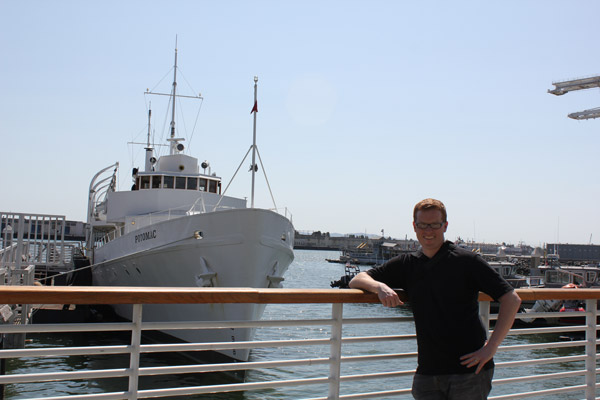
Rock the boat! FDR's "yacht" was an old Coast Guard cutter.
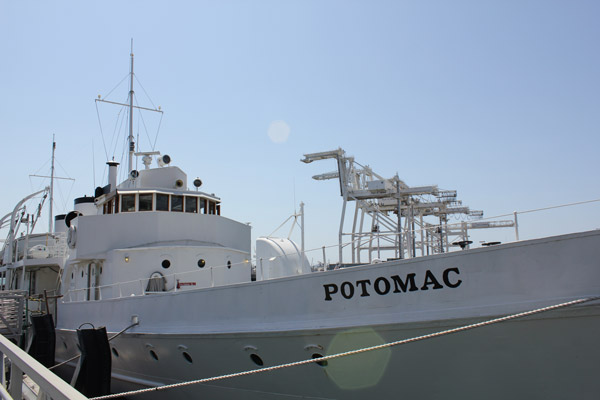
Just before getting permission to board.
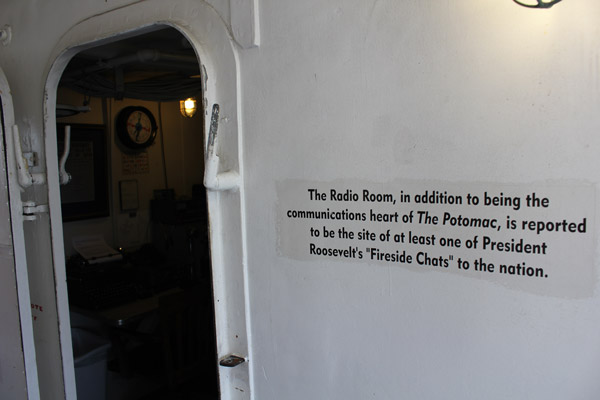
Some pictures are worth a thousad words. This one is worth around 35.
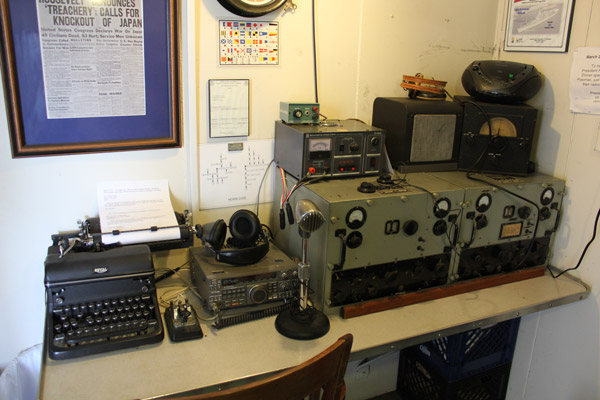
Not all fireside chats were fireside. The truth is out there.
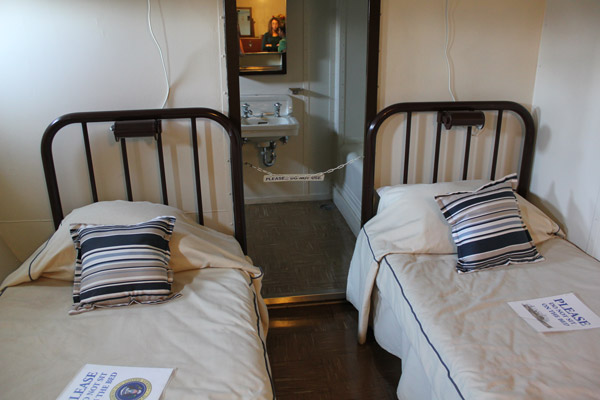
Luxurious guest quarters for the high seas!
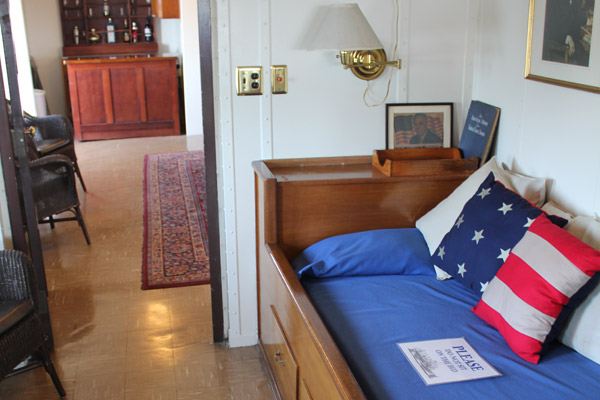
FDR's quarters. Note the lack of coaming to accomodate the wheelchair.
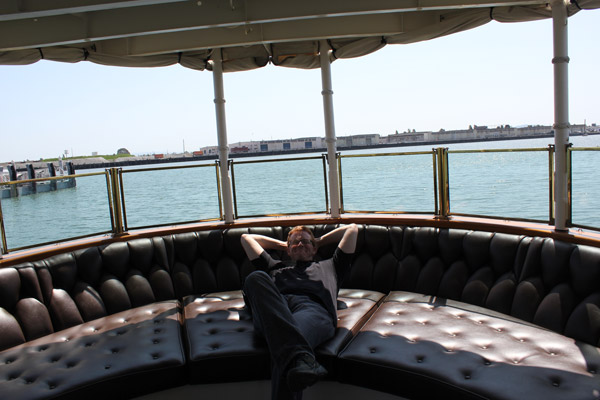
The extra-deep aft couch, great for fishing or adultery.
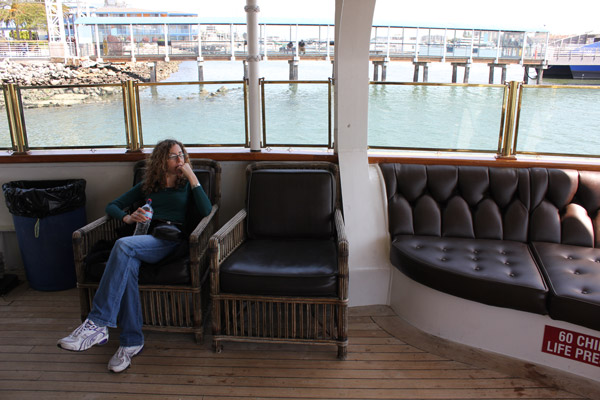
We're on a boat.
To put it politely, Oakland is a dump. The vibe you get from watching Raiders games on TV wis completely accurate. There's not much to see there if you're a casual tourist, but no one ever accused me of being casual. I wanted to see the USS Potomac.
Naturally, it has almost nothing to do with Oakland. The ship was built in the 1930s as a Coast Guard cutter -- the kind of vessel that would hunt down bootleggers. Franklin Roosevelt wanted a yacht, so it was transferred to his service. He used it for pleasure cruises and working vacations, until submarine warfare made presidential sea voyages a bad idea. After he died, it went back to the Coast Guard, and eventually got sold to private owners. Someone tried to take it to the Seattle World's Fair in 1962, but it crapped out on its way up the West Coast.
It kept changing hands. Elvis Presley bought the boat at one point, and he later donated it to a children's hospital, for sale at a fundraiser auction. Eventually it was used in a drug smuggling operation, got impounded by the U.S. government and was parked at Treasure Island, a naval station in the middle of the San Francisco Bay. It sank while in the dock. The Potomac was beat to hell, almost beyond recognition. On the verge of getting scrapped, it was bought by the Port of Oakland. They restored it, opened it to tourists, and sat back to watch the money pour in.
Which is to say, my wife and I were the only people there on an Easter Sunday. The Potomac is docked at the edge of Jack London Square, the bizarro version of San Francisco's Fisherman's Wharf. The sidewalks and restaurants were mostly empty, everything was a little bit grimier, and the surrounding area is mildly bombed out. But on the positive side, we didn't have to pay $40 for parking! We put our rental car on the street. Please note that this is ominous foreshadowing.
Some people take a complete lack of crowds as a bad sign. I look at it as the chance for an exclusive private tour at regular admission rates. And it was totally worth it.
Sailing was a huge part of FDR's identity -- remember, his first really big job was as assistant secretary of the Navy, and his family's wealth was built around maritime trade. Seeing FDR's boat is maybe the most FDR thing you can do. We got to check out the huge diesel engines below decks. We saw the front cabin, where the famous Filipino stewards slept. They took us to the guest quarters, where King George VI took one look and politely declined to sleep on board. Roosevelt even used the ship's communications room to deliver a fireside chat.
There are also some intriguing handi-capable modifications. The entrances to FDR's cabin had no coaming, to accommodate his wheelchair. He had a giant specialty tub installed in his private bathroom. The stern of the boat had a giant custom couch, about four feet deep -- it was a great space for FDR to stretch out his crippled legs and go fishing. There was even a second (and false) smokestack added to the top deck, to serve as the cosmetic cover for the personal elevator that FDR needed.
Our guide was tremendous. He was used to leading tours for grade-schoolers, and I think he was happy to talk about FDR like an actual person. Roosevelt liked to claim that he was working non-stop for the nation during the Depression, but the records pretty clearly showed that he went cruising on the Chesapeake Bay all the time. He was rich snob at heart, and that's what rich snobs do.
Eleanor Roosevelt was almost never on the Potomac; she liked to claim that she wasn't fond of sailing, but there are a few photos of her having a fine time on ships a lot smaller than that Potomac. In reality, the ship was another place where FDR could take a mistress. Polio should never keep you from banging around as much as possible. This is why FDR is an inspiration to disabled people everywhere. I casually slipped into conversation that we had also seen the USS Sequoia, the presidential yacht docked in Washington. Once the guide understood how cool we were, the tour seemed to be on a whole new level. I am saying this only sort of ironically.
You have to ease off that kind of high, so on leaving the Potomac we cruised Jack London Square for a bit. Jack London was apparently from Oakland, and the centerpiece of the square is a cabin he once stayed in while living in Alaska. Or half of it, at least. A bunch of the logs were used in a replica somewhere in Canada, and the rest went to Oakland. So you have an Alaskan cabin surrounded by palm trees. There's also a wolf statue. Heeding the call of the wild, we walked away after two minutes and got some gelato.
And then, we got to have our one truly authentic Oakland experience. When we returned to our car, we found that a rear window had been smashed, and the shoulder bag I had tucked under my seat was gone. Gone with it were our zoom lens, and my house key, and any chance that I will ever speak fondly of Oakland.
But the Potomac was awesome. Just Uber there if you're going.
The Ferdinand Magellan: Presidential Rail Car, 1943-1958
Visited in 2021.
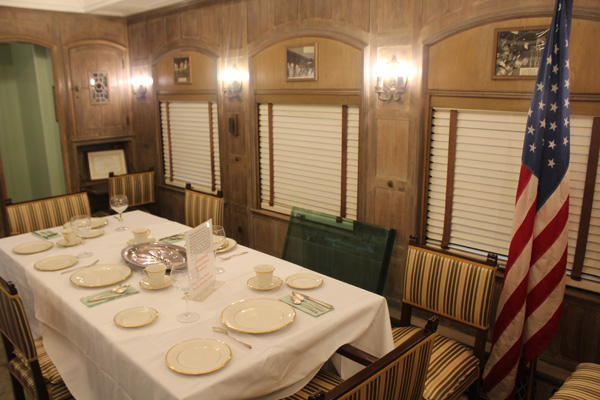
Fine dining at 35 mph. The dining car!
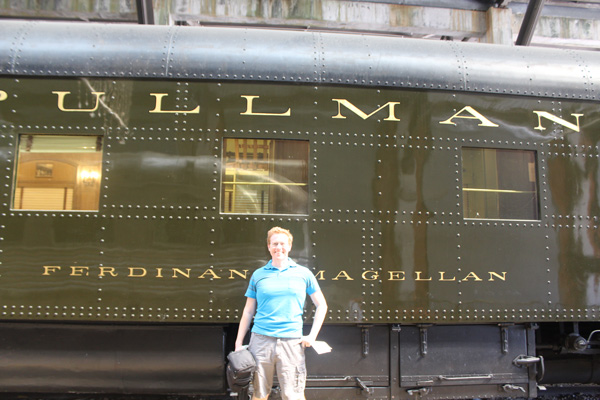
Checking out the armor plating (on the train, not my cargo shorts)
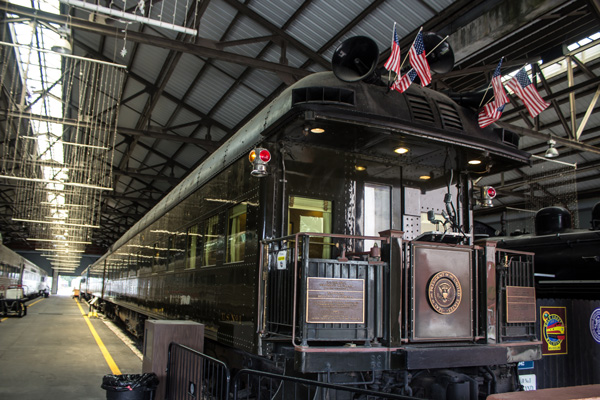
End of the line! The platform where Truman took his victory lap
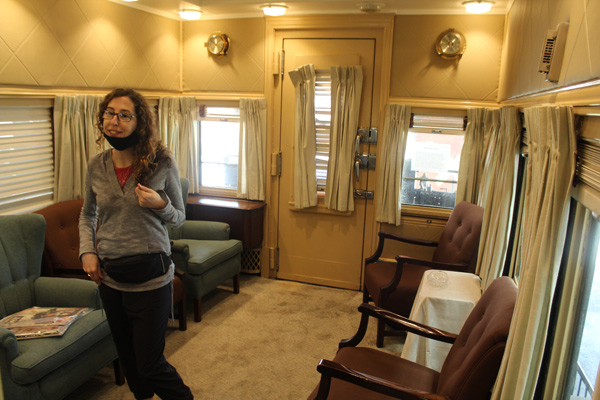
The lounge at the back of the president's rolling rumpus room.
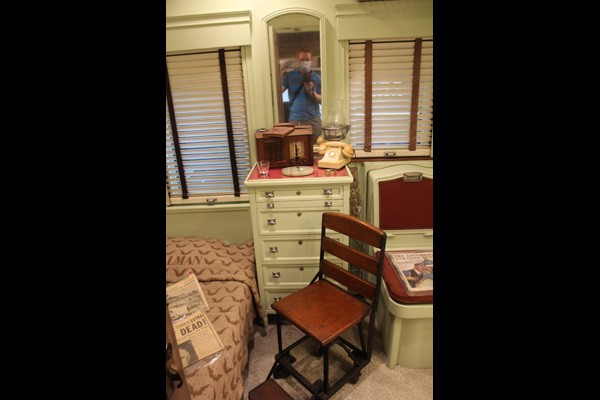
FDR's special accomodations.
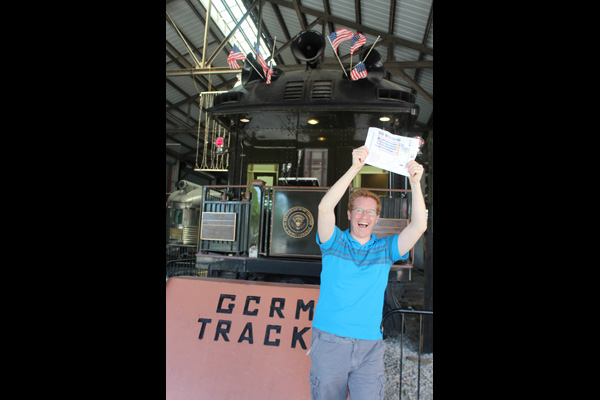
Dorky defeats embarrasment!
Air travel was a thing in the 1940s, but the industry hadn't quite figured out how to make it sexy. It wasn't fun to make out with your secretary when the engine noise was so loud, you'd never hear your wife approaching. You also couldn't have a delightful four-course dinner when random air pockets might launch the hot soup course onto your crotch at any moment. Why, that would make the canoodling even tougher!
No, in the 1940s, if you wanted discreet and sumptuous travel, rail was king. And the president of the United States deserved nothing less than the finest of rail cars. The Pullman Company was a luxury brand -- Abraham Lincoln's son had once been the president of the company! And you could modify a rail car to keep it safe from shadowy German saboteurs.
The Pullman company built six rail cars named after explorers -- although no one every explored anything via railroad -- and the U.S. government acquired the Ferdinand Magellan. It was modified with Nazi-proof armor plating, then put at the disposal of Franklin D. Roosevelt, a guy who knew something about rolling all over the place.
The Ferdinand Magellan served FDR, Harry Truman and Dwight Eisenhower before technological advances forced it into retirement. The government was ready to dump it on the ash heap of history, but the Gold Coast Railroad Museum -- in Miami -- snapped it up in the late 1950s. They have held it ever since, with a brief interlude to lend it to Ronald Reagan for a campaign event in 1984.
I finally got to visit this chariot of the gods in March 2021. (America was shut down, but Florida was open.) The first thing you need to realize about the Ferdinand Magellan: luxury is relative. Even after modifications -- a few bedrooms were converted into social areas -- it's not exactly spacious. The "hallway" between rooms is barely wide enough for my body, shoulder to shoulder -- so imagine the gymnastics required to get a customized FDR wheelchair back and forth. FDR enjoyed a little more personal space in his quarters, because his wife rarely traveled with him and took a separate cabin when she did. But it wasn't exactly the Ritz, and if he wanted to make time with his personal assistant everyone on board definitely would have known about it. He had the room to lay down, read a book, sign a few executive orders and not much else.
The dining room, at least, was the full width of the car. They squeezed in a decent sized dining table and slapped some wood paneling on the walls to class the place up; you could have a very classy dinner for eight, as long as no one was too beefy and everyone could hold their bladders for the course of the meal.
The observation lounge at the far end wasn't too bad, either. You could pal around with cronies or less-ethical journalists while relaxing in relatively comfortable chairs, watching the tracks disappear behind you. Of course, everyone was probably smoking, so the entire Ferdinand Magellan probably smelled like Satan's armpit. They would have been used to it back then, but the mustiness lives on today.
FDR rode about 50,000 miles in the Ferdinand Magellan, with his last trip being a dip down to his vacation home in Warm Springs, Georgia, in the spring of 1945. He used the train briefly when he was a corpse -- it carried his body up to Hyde Park for his funeral -- but they probably don't count that on his mileage totals.
It was Truman, however, that captured my imagination. Every news outlet had written Harry off in 1948, but he never gave up hope. The Magellan was one of his secret weapons, as he crossed the country in a whistlestop campaign and gave hundreds of speeches from the back platform. (It was rigged up with a presidential podium and a decent speaker system for just such occasions.) He was on the Magellan a few days after his victory, when someone handed him a copy of the Chicago Tribune with the famously flubbed headline, "Dewey Defeats Truman." He held it up for the crowds while standing on the back of the Magellan, posing for what is now one of the most famous photos in American history.
The Gold Coast Railroad Museum won't let you stand on the platform, but we got there early enough that they gave us free run of the interior. (The docent hadn't showed up yet.) They also have displays in other cars of past train menus (with a disturbing number of courses) and some info about how many workers it took to make the Magellan run. If you think the president was a little cramped, imagine where they stashed the gaggle of black and Filipino stewards who had to make the whole journey seem effortless.
It's a monument to another era -- and the timeless elegance of rail travel. Chugga chugga choo choo, y'all.
